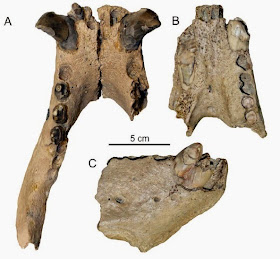Walruses (Odobenidae) are large Seals (Pinnipedia) related to Sea Lions and Fur Seals (Otariidae). The group first appears in the fossil record about 16 million years ago towards the end of the Early Miocene. The modern Walrus (Odobenus rosmarus) is one of the largest living Seals, and is a specialized shellfish eater, with well-developed tusks used to root out Clams, a thick moustache used to probe muddy sediments and a highly developed feeding system capable of sucking large Clams from their shells. Fossil Walruses, of which numerous species have been documented from the North Pacific region, apparently pursued a more diverse range of diets, with suction-feeding, specialist Fish eaters and generalist species all recorded.
Pelagiarctos thomasi is a large fossil Walrus described from partial remains from the Middle Miocene Sharktooth Hill Bonebed of Kern County, California in 1988. This has been identified as a large predatory Walrus, possibly a top-predator specializing in hunting other Marine Mammals, though it was initially described only from a partial lower jaw with most of the teeth missing.
In a paper published in the journal PLoS One on 16 January 2013, Robert Boessenecker of the Department of Geology at the University of Otago and the University of California Museum of Paleontology and Morgan Churchill of the Department of Geology and Geophysics and the Program in Ecology at the University of Wyoming, describe a second specimen of Pelagiarctos from the Middle Miocene ‘Topanga’ Formation of Orange County, California. The new specimen differs enough from the original that it is not placed within the species Pelagiarctos thomasi, but since modern Walruses are known to be somewhat morphologically variable, Boessenecker & Churchill refine from erecting a new species to describe it, instead referring to it as Pelagiarctos sp.
Mandibles of Pelagiarctos. Comparison of (A) Pelagiarctos sp. in dorsal aspect, and Pelagiarctos thomasi in (B) dorsal and (C) lateral aspect. Boessenecker & Churchill (2013).
The new specimen comprises the partial lower jaw of an animal similar to the first specimen, but this time with most of the teeth intact. Based upon comparison of these teeth to those of other large marine and predatory Mammals, Boessenecker & Churchill reject the idea that Pelagiarctos was a specialized predator hunting other large Marine Mammals. It was certainly a large animal, probably comparable to a Sea Lion in size, but its teeth were not exceptionally large and do not appear specialized for a subduing large prey, as its jaw structure, with robust strongly fused mandibles, while clearly strong, does not appear well suited to subduing large struggling prey or cracking the bones such animals, tasks which require a degree of flexibility apparently absent in the jaw of Pelagiarctos. Instead Boessenecker & Churchill suggest that Pelagiarctos was probably a more generalist feeder, which would have consumed the meat of large prey should this be available, but which principally ate fish or even foraged for shellfish.
See also…
Follow Sciency Thoughts on Facebook.




